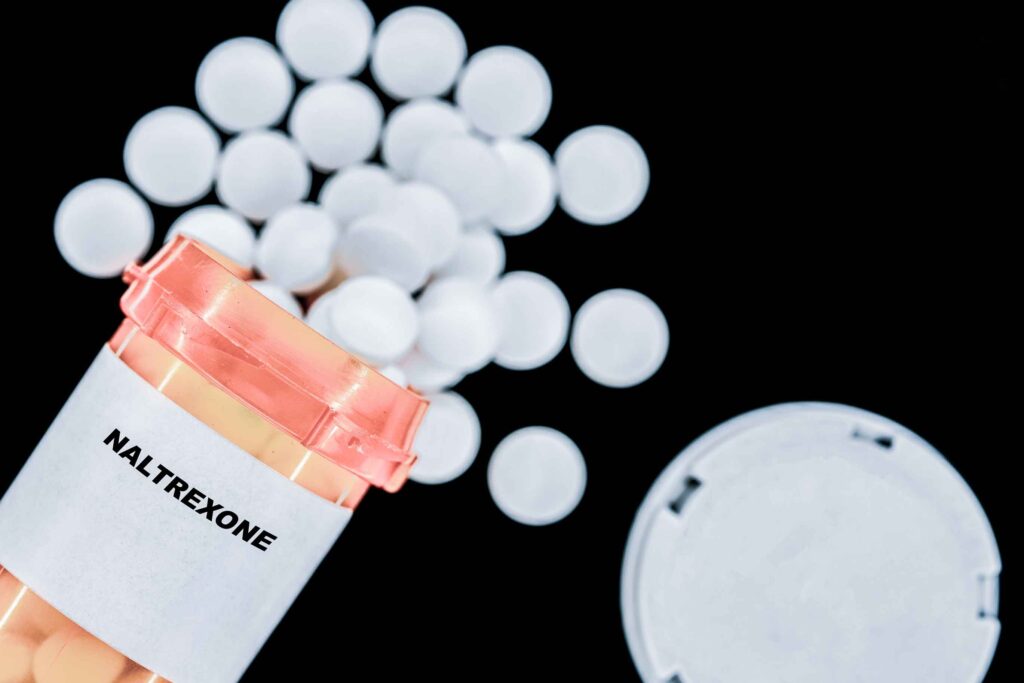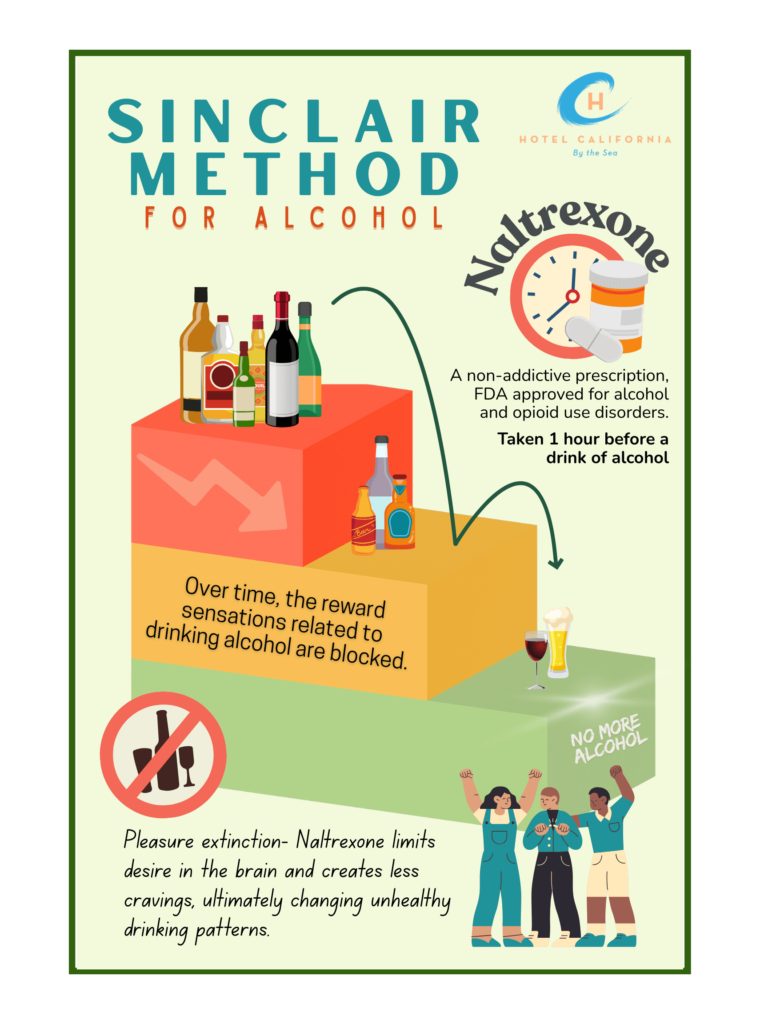The Sinclair Method for Alcohol
The Sinclair Method for alcohol is one of many techniques and approaches to alcohol addiction treatment. Unlike more traditional routes, which practice complete abstinence, the Sinclair Method is for those who may not want to or are not completely ready to cut out alcohol entirely. They may want to drink less. But they are not ready to take the final step in removing alcohol altogether.

In this method of alcohol treatment, patients take a naltrexone pill one hour before drinking. They must take it every time before they have a drink of alcohol. Naltrexone is meant to help limit their desire to drink due to its ability to block the euphoric effects of alcohol. Gradually, the brain will learn to separate alcohol from the reward of intoxication and slowly diminish the alcohol craving.
The idea behind the Sinclair Method is that over time, users will continue to experience less pleasurable feelings when drinking alcohol. Eventually, alcohol will become less desirable and users will lose the urge to stop drinking completely. Does this type of approach to alcohol treatment work? What are the risks and benefits of this non-traditional method?
What is Naltrexone? And why is it used in The Sinclair Method?
Naltrexone is an opioid antagonist that binds to the mu receptors in the brain. The prescription medication is FDA-approved for the treatment of opioid use disorder as well as alcohol use disorder. When taking naltrexone for alcohol use disorder treatment, users are usually given a 50mg dose daily or can receive a monthly injection.
Naltrexone is not addictive and does not induce feelings of withdrawal when you stop using it. This makes it a preferred method when it comes to medication-based alcohol use disorder treatment.
When drinking alcohol, the drug impacts the reward system. The brain links alcohol to rewarding behaviors. When rewards increase, it also increases the likelihood that the behavior will occur again, which compels users to continue drinking.
One of the reasons for alcohol addiction is the experienced rush of endorphins that occurs during intoxication. Drinking makes the user feel good. This feeling creates a link between alcohol and pleasure.
Naltrexone works by blocking the euphoric effects of opioids and alcohol when the drug is being used. The endorphins produced by alcohol have nowhere to land when they enter the system. Therefore, the pleasurable feelings of intoxication are lost or terminated. This process is also known as pharmacological extinction.
The term pharmacological extinction refers to the method that uses medication to break the link between alcohol intake and its intoxication reward in the brain. The term extinction is used in behavioral psychology to describe how a learned behavior can fade when it no longer receives the expected reward. With continued use of naltrexone, the ultimate goal and outcome is for the user to experience extinction due to the lack of feel-good sensations being blocked and ultimately changing unhealthy drinking patterns.

Side Effects of Naltrexone
- Increased nervousness
- Muscle or joint pain
- Headache
- Nausea
- Upset stomach
- Blurry vision
- Diarrhea
- Confusion
- Drowsiness
- Vomiting
What is The Sinclair Method?
The Sinclair Method is a medication-based approach to alcohol treatment. The technique was developed by Dr. John David Sinclair. He was engaging in animal research that highlighted how naltrexone was able to block alcohol reinforcing effects in animals. After research was moved to humans, a 2001 clinical study found that 78% of all people observed were able to reach a state in which they no longer desired alcohol. This occurred after several months.
The method works by reducing the reinforcement that users receive when they get drunk on alcohol. It blocks the euphoric feelings. And when the user continues to use the medication before drinking, the euphoric feelings are no longer associated with the reward system. It makes the user no longer feel the need to continue drinking, which prevents them from consuming too much alcohol. The idea is that it can make it easier not to drink and will eventually help cut out alcohol altogether.
It is a less commonly seen approach in the US. It is more common in other parts of the world such as Europe. This method doesn’t outright recommend complete abstinence from alcohol. Instead, it suggests that users consciously cut down on alcohol intake, which can lead to eventually cutting out alcohol on their own accord. The method has still not been thoroughly studied because addiction is a very complex condition. However, there have been some studies showing promising results in helping users with alcohol abuse.
Check Your Insurance Coverage for FREE
Find out if your insurance covers addiction treatment in minutes. We accept most insurance!
The process of the Sinclair Method on Alcohol
- Take naltrexone one hour before consuming alcohol
- Consume alcohol as per usual
- While drinking, the naltrexone helps to block pleasurable feelings that you normally experience when intoxicated with alcohol
- Less pleasurable feelings lead to less desire to drink
- You continue taking naltrexone 100% of the time that you drink alcohol
- Eventually, when you drink, you notice little to no rewards and no longer have the urge to drink
- This leads to less drinking or cessation of drinking altogether
Risks and Benefits of The Sinclair Method on Alcohol
Benefits
- Helps to reduce drinking without quitting entirely
- Can be helpful for those who want to drink socially on occasion but still desire to cut back for greater control over their alcohol consumption
- It can be a small step towards sobriety while minimizing the need for a medically supervised detox
- Does not require prior detox
- A more financially affordable and realistic option than intense detox and residential treatment programs
- It can help people who are still unwilling to quit drinking to drink at a safer level because it helps to gradually reduce alcohol intake and consumption
- Less likely to experience alcohol withdrawal because you are drinking less alcohol
- It can give back a sense of empowerment and control of your own drinking because you are making the decision to gradually cut down
Risks
- Extinction takes time with a slower timeline
- Treating alcohol use disorder with medication alone can remove a person’s motivation for personal growth through other aspects of treatment
- It can lead people to believe their doctor condones alcohol use
- It can lead people to develop a false sense of confidence in their ability to drink without getting dangerously intoxicated
- It may not treat the root cause of the addiction and it doesn’t address underlying triggers
- It holds patients accountable for their own treatment in taking naltrexone before every single drinking episode
- The medication must be consistently taken 100% of the time, otherwise the method does not work
- Cultural and social stigma
- It’s not a suitable technique for everyone
- Excessive alcohol use can still break through the naltrexone wall, in which users can generate pleasure again
- Naltrexone must be taken every single time before alcohol use in order for the method to be effective
Is the Sinclair Method for alcohol treatment Effective?
With the technique, it can take about 3 months or so for alcohol cravings to completely disappear. This is with consistent medication management. The Sinclair Method is not for everyone. One of the biggest issues with this method is that it requires the person to be consistent with taking naltrexone before every drinking episode. This can be a huge task for a person who wants to purposefully get drunk.
In more severe cases of alcohol use disorder, the person can easily stop taking the pill or wait a few months after the drug has worn off to drink again and experience the alcoholic high.
The Sinclair Method may be effective for people who are committed to making changes in their alcohol behavior, have adequate social support and are willing to be consistent and adhere to clinical instructions. But for those with a severe case of alcohol use disorder, it may not be enough to help in treatment.
Reach out to Hotel California by the Sea
We specialize in treating addiction and other co-occurring disorders, such as PTSD. Our Admissions specialists are available to walk you through the best options for treating your addiction.
Treatment for Alcohol Use Disorder
Researchers do not fully understand how naltrexone is able to block alcohol cravings. However, there is promising evidence that the Sinclair Method works and that naltrexone is an effective treatment medication for the use of alcohol addiction. Behavioral health treatment programs such as Hotel California by the Sea provide alcohol use disorder treatment for those who are struggling with alcohol addiction.
We offer treatment at all levels including detox, residential, PHP and IOP. We use evidence-based treatment methods such as CBT, DBT and family therapy. Hotel California by the Sea is dedicated to helping clients reach their goals in sobriety and overcome their addiction.
References:
https://www.hanleycenter.org/the-case-against-the-sinclair-method
https://www.verywellmind.com/the-sinclair-method-for-alcohol-addiction-recovery-7376184
https://www.choosingtherapy.com/sinclair-method
https://drugfree.org/article/sinclair-method/
https://renewhealth.com/sinclair-method-naltrexone-alcohol-reduction/
